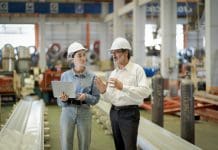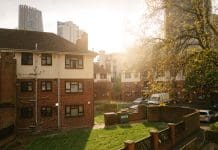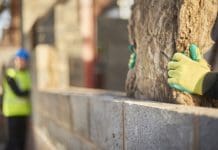The Committee on Climate Change has advised the government to use the Coronavirus crisis as a catalyst for reducing the construction industry’s carbon emissions and called for ministers to seize the opportunity to make the industry greener. Here Andrew Carpenter, chief executive of the Structural Timber Association, discusses how structural timber systems can help the UK construction industry to “build back better” by delivering both quality and sustainability assurances
We are at a critical crossroads – the world has woken up to the detrimental impact that we are having on the planet. Now is the time to invest in building in timber for not only safeguarding the environment and reaching net-zero carbon targets but also to deliver predictability of quality and performance.
This is a massive opportunity for the UK to make a sizable step-change and opt for more sustainable building technologies. There is a real positivity around our sector. Structural timber systems are now acknowledged as the optimum construction solution in the battle to reduce carbon emissions.
Trees are at the heart of the climate change debate
Once carbon sequestration was a natural phenomenon only understood by scientists but now that has all changed and terms such as “carbon sink” are commonly used. Commercially managed woodlands lock down a third more CO2 than wild forests – so the growing of timber for use in construction is vital in the battle to reduce carbon emissions.
Driven by intelligent and integrated construction solutions, from timber frame and structural insulated panel systems to glued laminated and cross laminated timber – innovations in the structural timber product range has broadened the appeal. In addition to the sustainability – cost savings, speed of build, faster return on capital outlay, reduction in waste, improved health and safety – are just some of the benefits of offsite timber construction.
The time is right for the construction industry to embrace innovative offsite timber technology to develop better buildings at a rapid rate to overcome the shortfall in housing stock, while delivering energy efficient buildings in a cost-effective quality manner across all construction sectors.
Modern structural timber systems are precision-engineered, strong and durable. The build method relies on factory-manufactured timber frame as a means of structural support – carrying the loads imposed by the floors and roofs, before transmitting them to the foundations, which can be built at a lower cost and less environmental impact due to the buildings being lightweight.
Timber frame currently accounts for around three-quarters of all new homes in Scotland, but England is lagging behind with a quarter of all new homes being built out of timber frame. This build method is utilised by every sector of the construction industry, including social housing providers, due to timber’s superb environment credentials – reducing energy consumption across the lifetime of the building, as well as being quick and easy to construct.
While other industries have made great strides to update and modernise, the construction industry has been a bit slower out of the starting blocks but now change is happening at pace.
But constructing in timber is not only about sustainability. With the messages from the Hackitt Review findings still ringing in our ears, the construction industry desperately needs more accountability surrounding the build process. We fully endorse the findings of Dame Judith Hackitt’s final report, Building a Safer Future, which outlines the “golden thread” – a new vision for the building control process, with the aim of increasing productivity, reducing costs and ensuring quality developments.
A period of intense transformation
The STA firmly believes that quality assurances should be an end-to-end process and that competency and compliance are crucial in achieving excellent standards across all construction projects. Over the last four years, the STA has been going through a period of intense transformation. A few might say this was a risky strategy, as we made some bold decisions which could have polarised some of our members. However, our sector by its very nature is innovative and when we outlined our plans surrounding quality, competency and compliance – our members understood the benefits and quickly got on board.
All structural timber building system supplier members must annually go through our independently assessed STA Assure Quality Management Scheme. The process is supportive and informative. Once members gain an understanding of the procedures and ultimately the benefits, we receive plaudits on how the assessments are conducted and how this has enhanced business processes and streamlined building control and warranty submissions.
But it is equally important for the standards that are achieved in controlled factory conditions, to be applied from the design stage right through to construction on site. This is why we embedded a Competency Scheme for Timber Frame Designers and Engineers within our STA Assure programme and a Competency Scheme Installers within our Site Safe Policy.
This makes certain that compliance and quality is an end-to-end process. We are proud that our award-winning Site Safe Policy has now been mandated by the HSE and is seen as an example for other material groups to follow.
We are now building on the UK’s outstanding heritage – timber architecture is having its moment; however, it is going to be far greater than that. It is a trend that has major potential for the future of building design and development. Continuous technical developments and the need for sustainable management of our resources are further reasons why timber systems are proving to be the material of choice for the decade.
Now is the time for timber to not only build back better but also greener. Now is the time to invest in building in timber; for the prosperity of the country and its residents, for employment, for the economy and – ultimately – for safeguarding the environment, today and tomorrow.
Andrew Carpenter
Chief executive
Twitter: STAtimber
LinkedIn: STAtimber
YouTube: STAtimber














